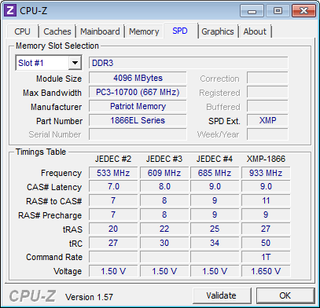Eight 8 GB (2 x 4 GB) Memory Kits For P67 Express, Rounded Up
Intel’s newest platform lineup has the same memory requirements as P55 Express, yet some of the modules available for it are rated differently. We discuss those differences on our quest to find the best performance/price in an 8 GB dual-channel kit.
Kingston And Patriot
Kingston HyperX T1 KHX1600C9D3T1K2/8GX
Kingston is one of several manufacturers to play it safe by sending modules that can run at rated settings on virtually any manually-configurable motherboard, using super-tall heat spreaders to visually separate its product from competing models. Of course these are still overclockable, and we intend to determine the extent of that capability.

Like all of today’s modules, Kingston’s DDR3-1600 CAS 9 uses an XMP profile to set its rated frequency and timings, defaulting to DDR3-1333 CAS 9 using SPD. Unlike other DDR3-1600 products, this one specifies the full 1.65 V limit of Intel’s previous-generation platform to guarantee stability.

Many builders have mentioned that voltage levels above 1.60 V are ineffective at boosting their LGA 1155 memory overclocks, and today we’re following the advice of those builders in our testing. That should give us a good idea whether 1.65 V is really required here.
Kingston provides a lifetime warranty on all of its DRAM products.
Patriot Viper Xtreme PXD38G1866ELK
Patriot shoots straight for an available multiplier with its DDR3-1866 Enhanced Latency Kit, yet retains the 1.65 V rating that many current users claim to be excessive. Whether or not settings in excess of 1.60 V are really useful likely depends on platform specifics, but we at least know that 1.65 V is supposed to be safe.
Stay on the Cutting Edge
Join the experts who read Tom's Hardware for the inside track on enthusiast PC tech news — and have for over 25 years. We'll send breaking news and in-depth reviews of CPUs, GPUs, AI, maker hardware and more straight to your inbox.

Because it uses a direct multiplier that’s available on most performance-oriented platforms, XMP-enabled motherboards configure the rated settings simply by selecting the profile in BIOS. Motherboards lacking this feature must be configured manually, as SPD defaults these to DDR3-1333 CAS 9.

Patriot offers a full lifetime warranty to the original purchaser of its DRAM products.
Most Popular


